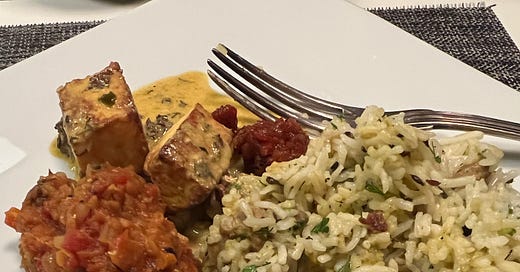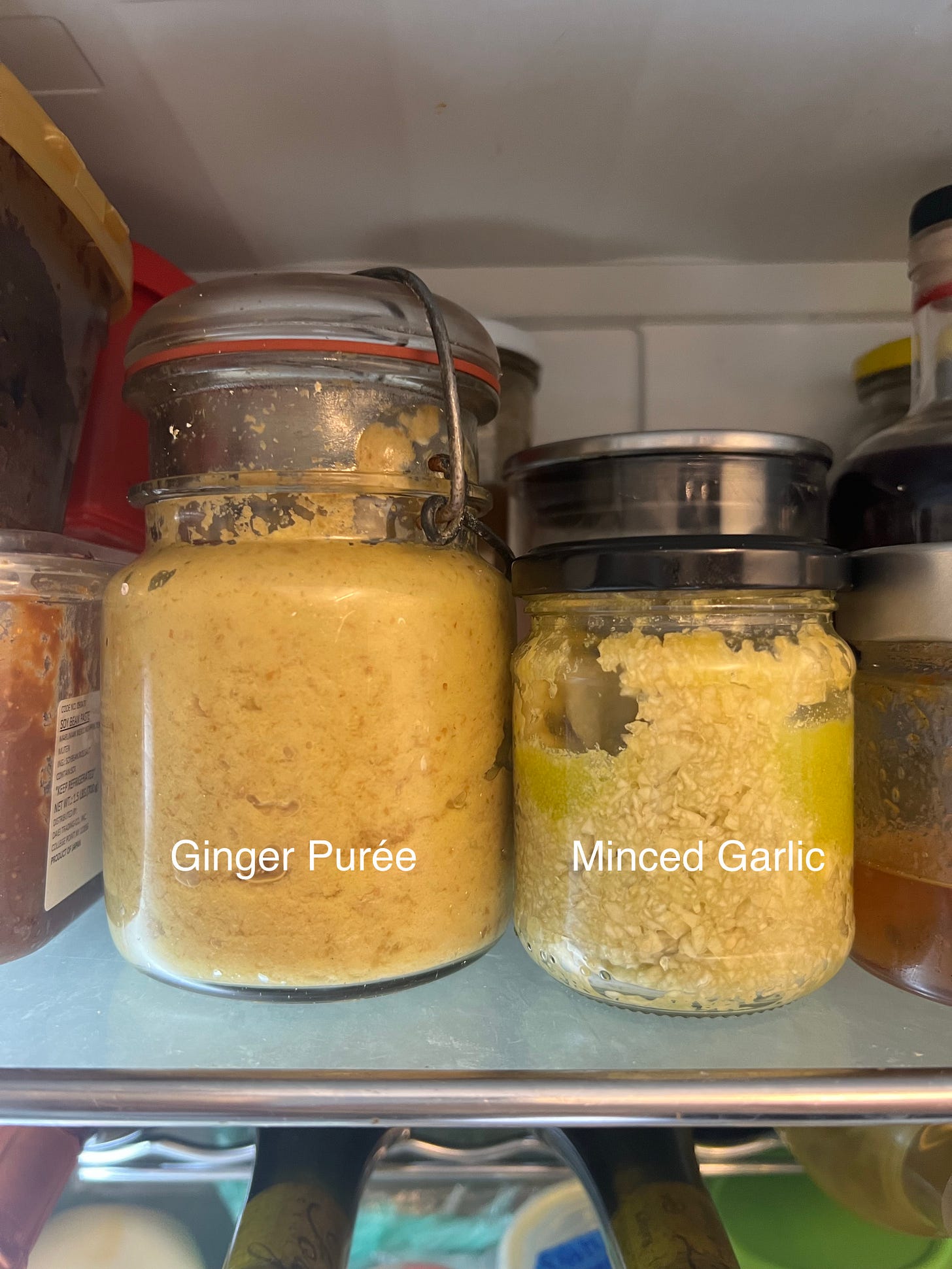Issue #91: Be a Dal
I Guess I'm Thirsty, A Recipe for Creamy Dal with Tomato and Coconut, Plus How to Make Your Own Coconut Milk
We’ve entered a busy period with several social obligations this week and next that are taking me out of the kitchen. While it’s nice to be eating other people’s food, to be honest, it’s a little discombobulating not to be cooking. And the fridges are full of things I need to use up. I’ll be doing my best to squeeze in some extra cooking time. In the meantime, I hope you enjoy these two dishes, so to speak, one Indian, one British.—Mitchell
I’ve been cooking a lot of Indian food lately. Though I’ve only been to India once—years back I spent a long weekend over Christmas in Mumbai—Indian cuisine has always been a fascination. Whenever I’m in Dubai, my friends, who took me to Mumbai, lead me to their favorite casual, regional Indian restaurants, the sort of places where a $2 order of pani poori includes eight poori that are filled consecutively as you eat them. Just a few weeks ago when I was back in the UAE, we ventured more upscale, to Trèsind Studio, where chef Himanshu Saini served a beautiful, multi-course Indian dégustation that was conceived as a regional tour of the country in one carefully choreographed menu.
Back at home, my Indian inspirations in the kitchen are many. They include Madhur Jaffrey, who’s been a longtime friend and whose books on my shelf are splattered and stained. Lately, I’ve been poring over Masala, by another friend, Anita Jaisinghani, whose butter chicken (Issue #78) is now a fixture in our dinner rotation, as is her ethereal beet soup, which I’ll write about sometime soon. The Instagram feed of British chef and cookbook author Romy Gill, also a bestie, is full of fast, flavorful dishes I save and tag for future meals. And I’m fortunate to get the occasional recipe or tip from celebrated New York City chef Chintan Pandya, who is one of my business partners in Flavor Five Studio. There are too many others to name.
And yet, somehow the dal that has snuck into my repertoire comes not from one of these great Indian cooks and colleagues, but from some thirst trap on TikTok I stumbled over because of an Instagram algorithm that clearly triangulated my interest in cooking and gay content. I don’t have much idea who @johngs is, besides a prolific, handsome British bloke whose full name is John Gregory-Smith, but I know that the Middle Eastern and Asian inflected food he cooks, often sleeveless, in his snappy videos looks hella tasty. His recipes are geared toward the home cook without losing any of their original character. I’ve cooked several of his dishes, including this dal, several times. I admit, I’m impressed.
Dal refers both to the vast category of split legumes used in Indian cooking and the curried dishes made from them that are ever-present in Indian meals. We use the term lentils to describe the many colored dals—red, pink, yellow, green, brown, and black—which go by names like masoor, moong, and urad dal. I’ll confess that I don’t always know the difference and sometimes in Indian stores I swear I see the same name on different lentils. I’ve a lot to learn.
Despite a fascination with eating and cooking Indian food, I am no expert. What I do know is that, as with most home cooking no matter the locale, once you have the ingredients, the actual cooking part isn’t that complicated. Despite the sense that we just got busy yesterday and needed to create convenience foods to help the modern home cook, no one in history has ever had enough time—certainly not before electricity and running water. There were takeout shops in Pompei, FCS! If you have what you need on hand, which likely means if you cook a particular genre of food regularly, you get into a swing of things, and that helps make it easier. For instance, since working through the recipes in Masala, I now keep homemade ginger purée and minced garlic in my fridge. This speeds up Indian cooking, for sure, but also Chinese and Italian.
What’s more, Nate’s love for Indian food overrides his distaste for legumes, and so dal is a good way to get healthy and environmentally friendly beans on our table. The range of Indian legumes is unmatched. And I am always conscious of doing my part for the Beans Is How campaign created by my friends and colleagues over at the SDG2 Advocacy Hub., with which they are trying to double the global consumption of beans and legumes in five years to help improve the health of the world’s population and the planet.
RECIPE: Creamy Dal with Tomato and Coconut
2 tablespoons oil, such as coconut, peanut, or olive
1 tablespoon cumin seeds
2 medium onions, finely chopped
4 cloves garlic, minced (about 1 ½ tablespoons)
1-inch piece of ginger, minced, or 1 1/2 tablespoon ginger purée
1 teaspoon turmeric
1 teaspoon kashmiri chili powder
1 cup (about 200g) red, green, brown, or black lentils
1 large (28-ounce) can diced tomatoes
1 cup coconut milk (see below)
2/3 cup water
Kosher salt
Juice of 1 lime
Chopped cilantro
Heat the oil in a large saucepan or Dutch oven over medium-high heat. Add the cumin and cook until it sizzles. Add the onion and sauté until soft, translucent, and starting to color, about 8 minutes. Add the garlic and ginger and cook another minute or two until fragrant. Add the turmeric and chili powder and cook another 30 seconds. Add the lentils, tomato, coconut milk, water, and a generous pinch of salt. Bring to a boil, cover, reduce the heat, and let simmer for 25 to 30 minutes, or until the lentils are tender. I like them to burst to make a thick dal, but stop them sooner if your prefer more al dente texture. If the mixture looks too dry, add some water. Stir in the lime juice and cilantro before serving. The dal can be made several days in advance and reheated to serve, adding a little additional water to loosen it so it doesn’t burn.
A Word About Coconut Milk
I’ve taken to using only fresh-frozen coconut milk from Thailand in recipes that call for it, as I find the flavor and texture of the milk unbeatable. I’ve found two brands in the U.S. market available in shops in Chinatown and at specialty stores, such as Kalustyan’s. But it is pricy. And I seem to be using a lot these days. So, I started experimenting with making my own coconut milk and the results are pretty great. To do so, you place about 2 cups (8 ounces, 200g) unsweetened, shredded, desiccated coconut in a blender and soak it in 4 cups (1 quart, 1 liter) hot water for at least 30 minutes, and up to 12 hours. Blend for a while on high until you have a smooth, creamy milk, and then strain that milk through a cheese-cloth-lined, fine-mesh strainer or nut bag if you have one (for making nut milks, no jokes please). I freeze the milk in 1-cup containers so it’s ready to use in recipes like this dal. The milk separates sometimes when it defrosts, but so does the imported stuff, and it doesn’t impact the results.
For added umami, instead of water I sometimes soak the coconut in kombu dashi (1/4 ounce of dried kombu steeped in 3 to 4 cups cold water for 24 hours in the fridge), a trick I learned from Laurent Gras, who used it to make almond milk for a recipe he created when we were writing articles together for Saveur magazine.
Note, I haven’t yet determined the best use for the pulp leftover from making coconut milk, but I’m working on it. Stay tuned to future issues of this newsletter.






